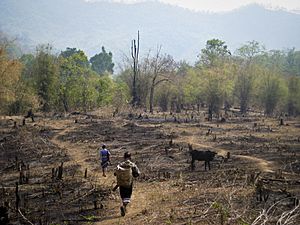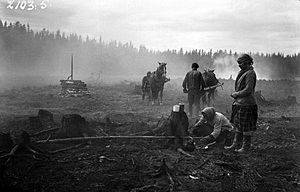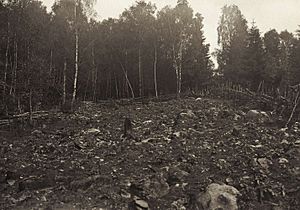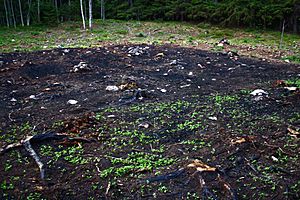Slash-and-burn agriculture facts for kids

Slash-and-burn agriculture is a traditional way of farming. It involves cutting down trees and plants in a forest area. Then, these cut plants are left to dry. After drying, they are burned. This burning creates a field called a swidden. The ash from the burned plants makes the soil rich in nutrients. This helps crops grow well for a few years. It also temporarily gets rid of weeds and pests.
After about three to five years, the soil loses its richness. Farmers then abandon the plot. They move to a new forest area to repeat the process. The old field is left to recover. This recovery can take from five to over twenty years. After this time, the plot can be used again. In Bangladesh and India, this practice is known as jhum or jhoom.
About 200 to 300 million people worldwide use slash-and-burn farming. While it provides food, it can cause deforestation (cutting down too many trees). It also leads to habitat loss for animals. Historically, it was sustainable when fewer people lived in an area. But with more people, it leads to faster deforestation. This affects the Earth's climate.
Contents
What is Slash-and-Burn Farming?
This farming method is a type of shifting cultivation. It helps farmers create new fields for crops. The first step is to cut down trees and other plants. These cut plants are called "slash." They are left to dry, usually before the rainy season. Then, the dried plants are burned. The ash that remains is full of nutrients. This ash makes the soil more fertile. It also helps to clear out weeds and pests.
Farmers can grow crops in these fields for a few years. But the soil eventually loses its nutrients. Weeds and pests also return. When this happens, farmers move to a new area. They start the process again. The old field is left alone. This allows the forest to grow back.
A Look at Its History
Slash-and-burn farming has been used for a very long time. Even hunter-gatherers used fire before farming began. They used fire to create clearings. These clearings helped new plants grow for game animals. They also promoted certain edible plants.
During the Neolithic Revolution, people started farming. They learned to grow plants and raise animals. This allowed them to settle down. Some groups could farm in open fields. But others had forests covering their land. So, since ancient times, slash-and-burn was used. It helped clear land for crops and livestock.
In ancient Europe, large families often moved through woodlands. They would burn and farm their plots. They grew crops and then moved to the next plot. This was a common way of life.
How Farmers Use This Technique

Slash-and-burn fields are usually used by a family. They farm the land until the soil is no longer fertile. Then, they leave the field. Trees and shrubs are allowed to grow back. After many years, another family might use the land. This system often means land is not bought or sold. Instead, families have traditional rights to use it.
Farmers typically cut down forests months before a dry season. The "slash" dries out. Then, it is burned in the dry season. The ash fertilizes the soil. The burned field is then planted. This usually happens at the start of the next rainy season. Crops like rice, maize, or cassava are common. Farmers once used simple tools. These included machetes, axes, hoes, and shovels.
Benefits and Challenges
This farming method provides food and income for millions of people. It has been sustainable for thousands of years. In many tropical regions, like the Amazon, the soil is naturally poor. Slash-and-burn is often one of the only ways to farm there.
Farmers often plant many different crops. This is better for biodiversity than growing just one crop. Traditional slash-and-burn usually does not harm the whole ecosystem. It only affects a small area temporarily.
However, this method is not good for growing cash crops. It needs a lot of land or a small population to be sustainable. If slash-and-burn is done too often in the same area, the forest can be destroyed. This happens when the human population grows too large.
Where is it Practiced?
Asia's Jhum Farming
In Northeast India and parts of Bangladesh, this farming is called jhum or podu. Tribal groups use it to grow important crops. These include upland rice, vegetables, and fruits. After a few cycles, the soil's fertility drops. Then, a new area is chosen. Jhum farming is often done on thickly-forested hills. Farmers cut treetops to let sunlight reach the ground. They burn trees and grasses for fresh soil. While this helps fertilize the land, it can also make it prone to erosion.
In Vietnam, many ethnic groups live in rural areas. They still use slash-and-burn agriculture as part of their daily lives.
Ancient Practices in the Americas
Some ancient American civilizations, like the Maya, used slash-and-burn farming. Native Americans in the United States also used fire for farming and hunting. In the Amazon, many people, such as the Yanomami Indians, rely on this method. This is because the Amazon's soil quality is poor.
Slash-and-Burn in Northern Europe
Slash-and-burn techniques were also used in northern Europe. In Sweden, it was known as svedjebruk. This practice started in Russia. It spread to Finland and eastern Sweden during the Middle Ages. Finnish settlers brought it to western Sweden in the 16th century. They helped clear dense forests. Later, it spread to eastern Norway.

The Telkkämäki Nature Reserve in Kaavi, Finland, is an open-air museum. It shows how slash-and-burn agriculture was done. Visitors can see how people farmed when this method was common. This was especially true in eastern Finland starting in the 15th century. Parts of the reserve are still burned each year to demonstrate the technique.
The svedjebruk method involved cutting or ringing bark from coniferous trees. This allowed them to dry. Then, the dried forest was set on fire. Crops were grown on the fertile ash-covered soil. The ash was very fertile but only for a short time. Farmers often planted rye first. Later, they might plant turnips or cabbages.
This farming needed new forest to be cut and burned every year. Fields needed 10–30 years to regrow. So, homes were often far from the fields. Large families worked together in communities. This method required a lot of land. When forests were plentiful, farmers did well. But as populations grew, it became harder to find new areas to burn.
Modern Research and Alternatives
Many environmental groups discourage slash-and-burn farming. They suggest other methods. One idea is to switch to more intensive, permanent farming. Another is to help farmers find different jobs. Some groups also help farmers improve their productivity. They introduce new farming techniques.
One idea is to not burn all the vegetation. Instead, some charcoal is ploughed into the soil. This method is called 'slash-and-char'. It can help boost crop yields.
Another project suggested growing crops like black pepper, turmeric, and corn. These would be planted between Inga trees. This method is called 'Inga alley cropping'. It aims to reduce the need for slash-and-burn.
A method called 'slash-and-cover' is used for growing beans in Central America. Researchers have suggested planting leguminous shrubs. These shrubs would act as a fallow crop. They would help restore the soil after it is exhausted.
Gallery
-
Arunachal Pradesh, India
See also
 In Spanish: Tala y quema para niños
In Spanish: Tala y quema para niños




